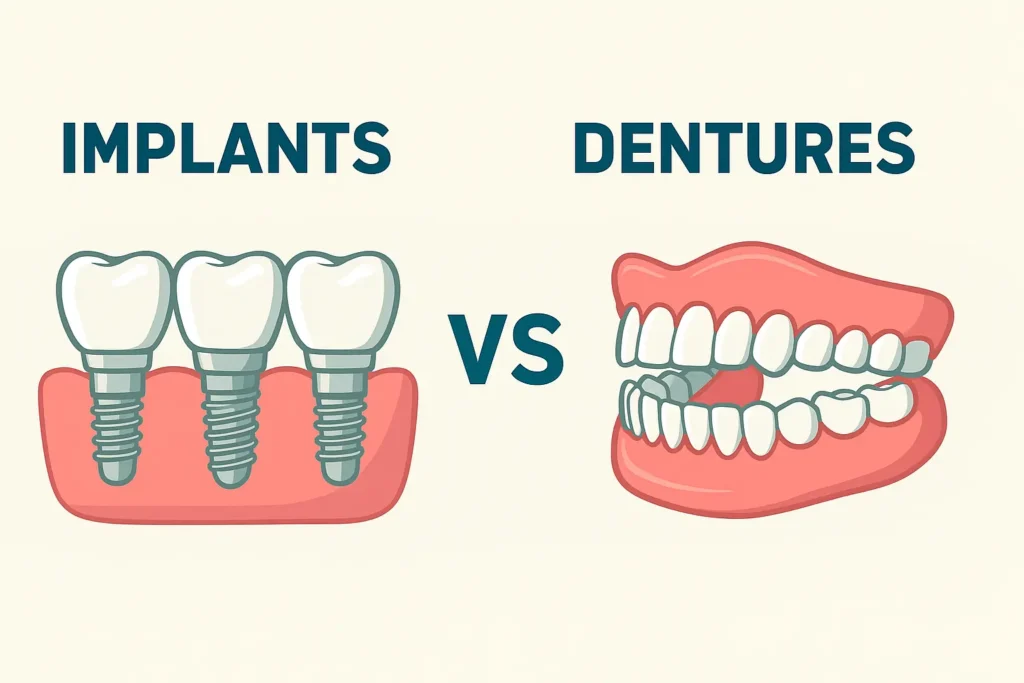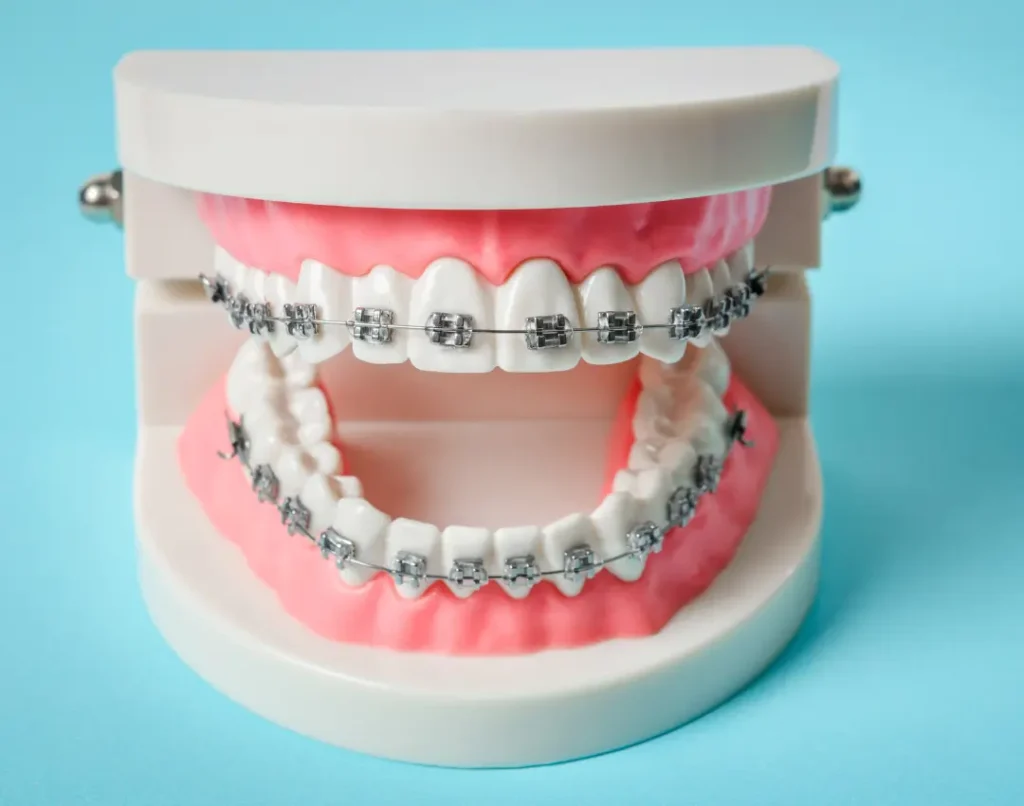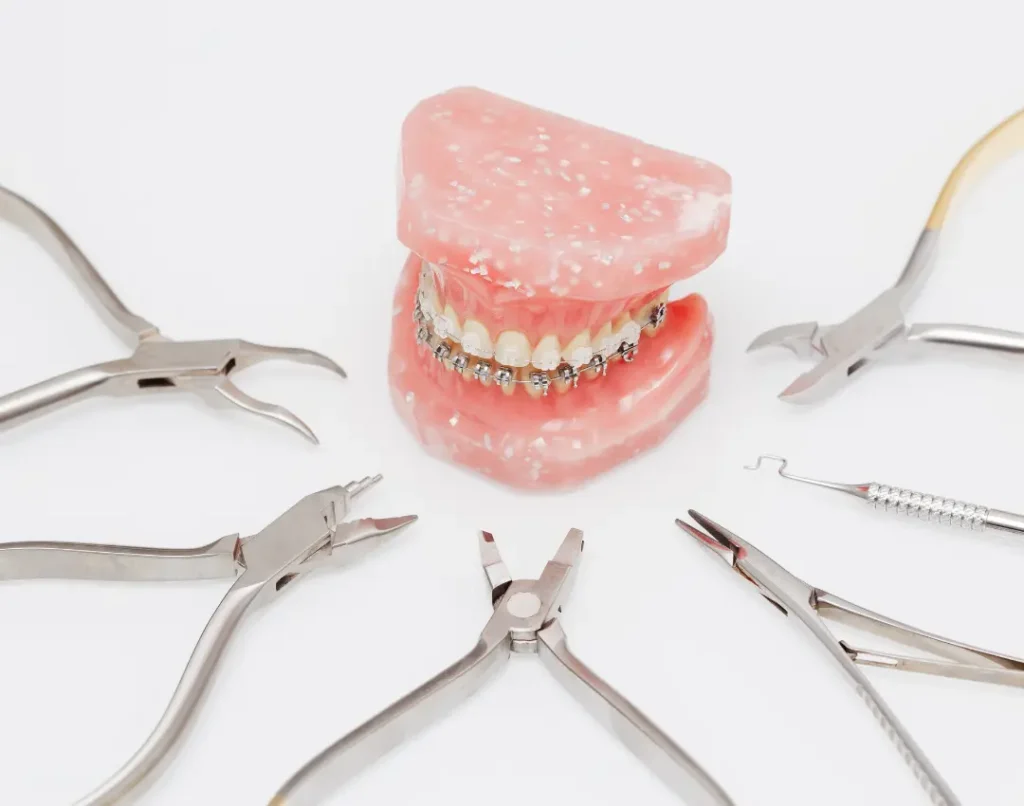“Why do I experience tooth sensitivity after filling? Is it normal? Why is it happening? What should I do?”
These are some of the most common questions patients ask me—and if you’re wondering the same, you’re not alone. Feeling worried because your tooth is sensitive after a filling is completely normal. In fact, mild to moderate sensitivity—especially to hot, cold, or pressure—is a common part of the healing process after dental work.
Most of us have felt tenderness when our skin is bruised or healing from a small cut. Your tooth can react in a similar way. But this discomfort usually improves within a few days to a couple of weeks as your tooth adjusts to the new filling. In the meantime, simple steps like using desensitising toothpaste can really help ease the discomfort.
In this guide, I’ll explain why tooth sensitivity happens after a filling, how your tooth’s nerve reacts, and what you can do to feel better quickly. Plus, I’ll help you understand when pain might be a sign of a bigger problem—and when it’s time to check back in with your dentist.
When your dentist does a filling, they are repairing damage to your tooth, usually because of a cavity. To do this, they need to:
1️⃣ Remove the decayed (infected) part of the tooth.
2️⃣ Clean the area really well.
3️⃣ Place the new filling material into the cleaned-out space.
While this process is necessary to save your tooth, it can irritate your tooth’s nerve endings, much like how your skin might feel sore after a small cut is cleaned and bandaged.
It’s completely normal to wonder why your tooth feels sensitive after filling. The truth is, even though your dentist has carefully repaired the damage, your tooth has been through a bit of a “disturbance”—and it needs time to settle down. Here are the main reasons why sensitivity happens after a filling:
Inside every tooth is a soft centre called the pulp, which holds nerves and blood vessels. During the filling process, your dentist may need to drill and clean close to this area, especially if the cavity was deep. Even if the nerve isn’t touched directly, the vibrations, heat, and pressure from dental tools can irritate the nerve endings.

Think of it like a bruise under your skin—it’s tender for a little while as it heals.
Why Does the Nerve React This Way?The nerves inside your tooth are like tiny alarm bells. Their job is to:
So, when they get disturbed by drilling, the new material, or even a slightly high bite, they send out warning signals in the form of sensitivity or pain. |
After the filling is placed, your tooth might experience new pressure points, especially when you bite down or chew. This is because the tooth’s structure has slightly changed, and your mouth is adjusting to the new shape. This can make the tooth feel sensitive to pressure for a short period, which typically improves within days or weeks.
Sometimes, even with precise dental work, the new filling may be slightly too high. When that happens, your tooth hits the opposite tooth harder than it should when you close your mouth or chew. This extra force irritates the nerve and can cause ongoing sensitivity or even a sharp pain when biting.
If this is the cause, it’s an easy fix—your dentist can quickly adjust the height of the filling to restore a comfortable bite.
Most sensitivity after a filling is caused by your tooth’s natural reaction to the repair work. The nerves need a little time to calm down, but if discomfort continues or worsens, it’s important to get your bite and filling checked.
The kind of filling material used can also play a role in how sensitive your tooth feels after treatment.
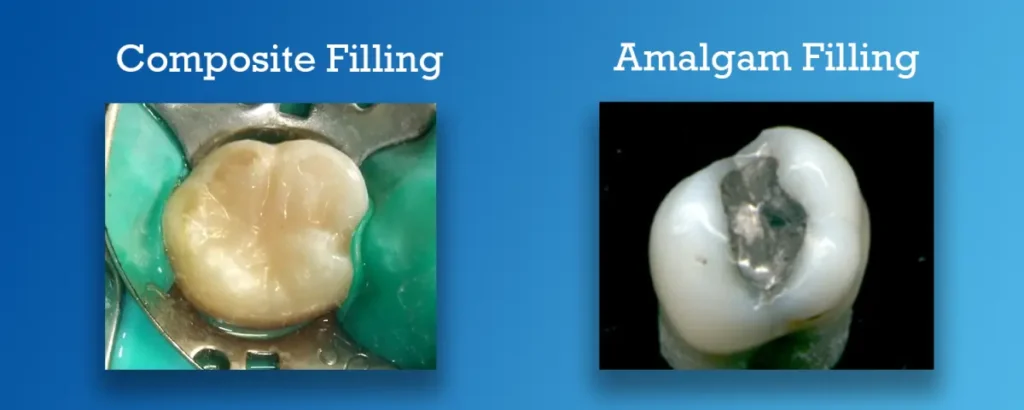
The structure of your tooth plays a big part in how it reacts after a filling.
If your cavity was shallow, the dentist works far away from your tooth’s nerve, so sensitivity is less likely.
But if your cavity was deep, the dentist has to clean close to the dentin layer and possibly near the pulp (nerve center).
The closer the work gets to the nerve, the higher the chance of temporary sensitivity after the filling.
Ever felt like your tooth has a little heartbeat after a filling? That’s because the pulp inside your tooth has blood vessels, and when the area is irritated, it becomes a bit inflamed. That swelling inside the tiny tooth space can make you feel a throbbing or pulsing sensation. This is usually short-lived, but if it persists or worsens, it’s a good reason to check with your dentist.
If you’re dealing with a sensitive tooth after a filling, one of the first questions on your mind is likely: “How long will this last?” The good news is that, in most cases, sensitivity is temporary and part of your tooth’s natural healing process.
Here’s what to expect—and when to be concerned.
For most people, tooth sensitivity after a filling starts right away or within a few hours after the procedure. Here’s a general timeline:
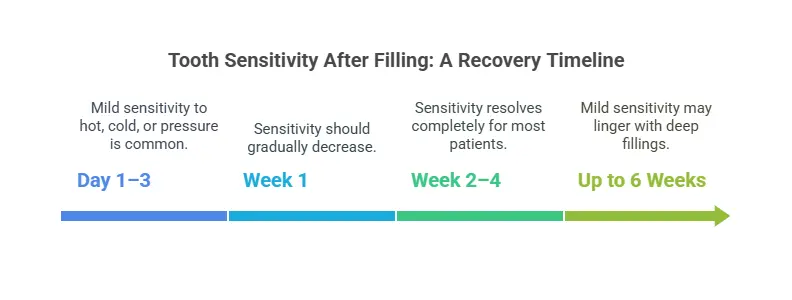
You might experience:
Feeling that the filled tooth is more “aware” of pressure compared to other teeth
As long as these symptoms are mild to moderate and gradually improving, they are typically nothing to worry about.
It’s important to listen to your body—and your tooth! Contact your dentist if you notice:

These signs may mean your tooth’s nerve is more inflamed than expected or there’s a problem with the filling that needs attention.
In most cases, sensitivity goes away completely once your tooth has healed. However, in rare situations—such as when a filling is very close to the nerve or if there’s hidden damage—the sensitivity may persist or worsen.
If that happens, your dentist may discuss additional treatment options, like:
Root canal therapy (only if the nerve is badly inflamed)
The key takeaway? Long-term sensitivity is uncommon, and your dentist is there to help ensure your tooth stays healthy and pain-free.
Tooth sensitivity after a filling is typically short-lived and part of your body’s natural healing response. Most people feel fully back to normal within a few weeks, but it’s always wise to reach out to your dentist if something doesn’t feel right.
While most sensitivity after a filling is perfectly normal and improves with time, it’s important to know when it might signal a bigger issue. Catching a problem early can prevent discomfort from turning into something more serious.
Here’s how to spot warning signs—and what your dentist will do to get to the root of the problem.
Wondering if your filling might be the reason for your ongoing sensitivity? Here are a few simple ways to assess:
If anything feels unusual or seems to be getting worse over time, it’s a good idea to check in with your dentist.
If you visit your dentist with concerns, here’s what they typically do to figure out what’s going on:
Your dentist will look closely at the filling to check for any visible signs of:
Dental X-rays can see inside your tooth and under the filling to spot:
If your sensitivity seems related to biting or chewing, your dentist might:
This helps them fine-tune your bite and relieve extra pressure on the tooth.
Sometimes, the filling itself may be the problem. Here’s what could be going wrong:
Over time (or even right after placement), fillings can:
These can let bacteria sneak back in, causing sensitivity, decay, or infection.
If the cavity was deep, there’s a small chance the tooth’s nerve becomes:
Overly sensitive due to hidden damage
In these cases, your dentist may discuss options like:
Mild sensitivity is usually nothing to worry about, but trust your instincts. If your discomfort is severe, persistent, or getting worse, your dentist can pinpoint the problem and help you feel better fast.
If your tooth is feeling sensitive after a filling, the good news is that there are many ways to ease the discomfort. Here’s what you can try at home—and what your dentist can do if the problem continues.
Using toothpaste designed for sensitive teeth (like Sensodyne) can block nerve signals and reduce discomfort. Brush gently twice a day for best results.
A warm saltwater rinse (½ teaspoon of salt in a cup of warm water) helps soothe irritated tissues and keep your mouth clean.
Medications like ibuprofen or acetaminophen can ease both pain and inflammation. Always follow the package instructions.
Ice packs placed on your cheek (never directly on the tooth) can reduce swelling and dull the pain. However, avoid putting ice inside your mouth, as extreme cold can make sensitivity worse.
To minimise discomfort, steer clear of:
Your dentist can apply a special fluoride varnish or desensitising gel to help strengthen the tooth and calm the nerve.
If your bite feels “off” or pressure triggers sharp pain, your dentist may adjust the filling’s height or replace it if there’s a problem.
If the nerve is severely inflamed or infected and nothing else helps, your dentist may recommend a root canal to save the tooth and relieve the pain.
While some sensitivity is unavoidable, there are smart ways to reduce your risk before and after getting a filling.
Discuss with your dentist which filling material works best for your tooth’s location and your sensitivity history. Tooth-colored composites are great for aesthetics, but materials like gold or ceramic may be less sensitive for some people.
A precise, careful filling placement reduces the chance of nerve irritation and bite misalignment, so always choose a skilled dentist you trust.
Routine dental visits help spot problems early before they turn serious.
Gum recession can expose sensitive parts of the tooth. Gentle brushing and good oral care can help keep your gums healthy and your sensitivity low.
Certain people are more prone to sensitivity after fillings. Here’s what to watch for:
What you eat and how you live can impact your tooth sensitivity.
Avoid or limit:
Your dentist may schedule a check-up to ensure everything is healing well.
Most sensitivity fades, but here’s what you should know about the long-term outlook.
Not usually—if managed well, the sensitivity shouldn’t cause new problems. However, unaddressed issues (like a leaky filling) can lead to decay or infection.
Mild sensitivity may limit certain foods/drinks for a short time, but typically doesn’t interfere with your daily routine long-term.
Yes! For most people, the tooth adapts and heals fully within weeks, and sensitivity fades away.
Dental technology is always improving—here’s what’s new.
Modern filling materials are designed to be:
Lasers can help:
Scientists are exploring stem cell therapies and regenerative materials to one day heal damaged nerves and tissues naturally.
Staying informed and communicating well with your dentist is key to comfort and confidence.
Be clear about:
Understanding your treatment helps reduce anxiety and keeps you in control of your dental health. Knowledge really is power when it comes to a healthy, comfortable smile.


